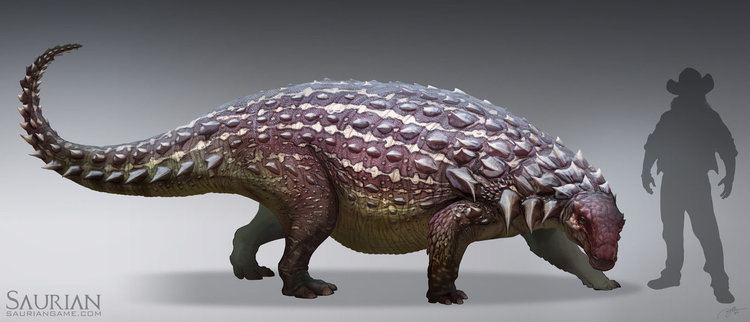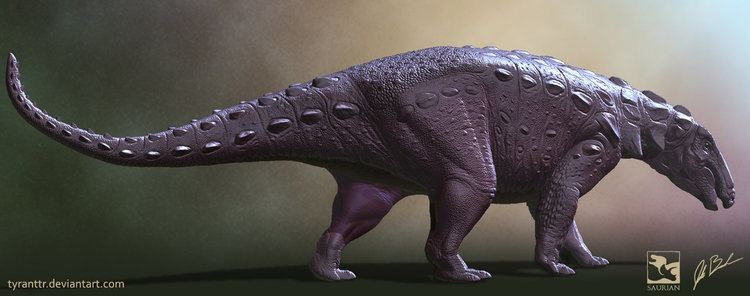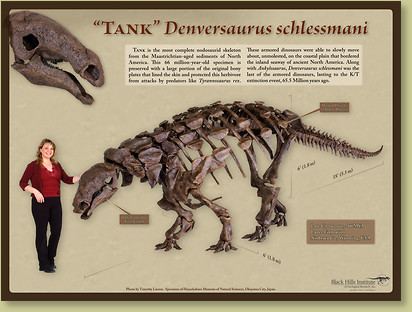Rank Genus | Class Reptilia Phylum Chordata | |
Similar Anoplosaurus, Dyoplosaurus, Anodontosaurus, Chialingosaurus, Paranthodon | ||
Denversaurus s mad world
Denversaurus (meaning "Denver lizard") is a genus of herbivorous nodosaurid ankylosaurian dinosaur from the Late Cretaceous (late Maastrichtian) of western North America. Although treated as a junior synonym of Edmontonia by some workers, subsequent research indicates that it is a distinct nodosaurid genus.
Contents

Description
In 2010, Gregory S. Paul estimated the length of Denversaurus at six meters, its weight at three tonnes.

Bakker considered Denversaurus distinct from Edmontonia and Chassternbergia in having a skull wide at the rear, with a more rearward position of the eye sockets. The holotype skull has a length of 496 millimetres and a rear width of 346 millimetres. In the referred specimen AMNH 3076 these proportions are less extreme, measuring 395 by 220 millimetre. According to Carpenter, the greater width was due to crushing.

The study by Burns concluded that Denversaurus was different from Edmontonia but similar to Panoplosaurus in having inflated, convex, cranial sculpturing with visible sulci, or troughs, between individual top skull armour elements, but is distinct from Panoplosaurus in having a relatively wider snout.
Discovery and naming

In 1922, Philip Reinheimer, a collector and technician employed by the Colorado Museum of Natural History, the predecessor of the present Denver Museum of Nature and Science, near the Dwito or Twito Ranch in Corson County, South Dakota discovered the fossil of an ankylosaurian. In 1943, Barnum Brown referred the find to Edmontonia longiceps.

In 1988, Robert Thomas Bakker decided to split the genus Edmontonia. The species Edmontonia rugosidens he made into a separate genus Chassternbergia and the Denver fossil was named and described as a new genus and species. The type species of this genus was Denversaurus schlessmani. The generic name referred to the Denver Museum of Natural History at Denver, Colorado. The specific name honoured Lee E. Schlessman, a major benefactor of the museum and the founder of the Schlessman Family Foundation.

The fossil the species is based on, the holotype DMNH 468, had been discovered in a layer of the late Maastrichtian-age Lance Formation of South Dakota. It consists of a skull, lacking the lower jaws, and osteoderms of the body armour. It is part of the collection of the Denver Museum of Nature and Science for which the genus was named. Bakker referred a second fossil to the species, specimen AMNH 3076, a skull found by Brown and Roland Bird at the Tornillo Creek in Brewster County, Texas, in a layer of the Aguja Formation, possibly from the Maastrichtian also.
The Black Hills Institute has found a nodosaurid skeleton in Niobrara County, Wyoming, nick-named "Tank", which it has identified as Denversaurus. It contains the lower jaws, parts of the torso and about a hundred osteoderms. It is part of the collection of the Rocky Mountain Dinosaur Resource Center under inventory number BHI 127327.
Validity
The validity of Denversaurus was disputed in a 1990 paper on ankylosaurian systematics by Kenneth Carpenter, who noted that Bakker's diagnosis of Denversaurus was based primarily on Bakker's artistic restoration of the holotype in an uncrushed state. Since DMNH 468 was found crushed, Carpenter assigned Denversaurus to a Edmontonia sp., even though he noted its similarity to Chassternbergia (as Edmontonia rugosidens). A number of workers treated Denversaurus as synonymous with either E. rugosidens or E. longiceps, or alternatively a valid species of Edmontonia, an Edmontonia schlessmani.
In a SVP 2015 abstract, Michael Burns revisited the systematics of latest Cretaceous nodosaurids from the Western Interior. According to Burns, Denversaurus is a valid taxon based on its phylogenetic position.
Classification
Bakker in 1988 placed Denversaurus within an Edmontoniidae, the presumed sister group of the Nodosauridae within a Nodosauroidea that would not have been Ankylosauria but the last surviving Stegosauria. These hypotheses have not been confirmed by modern cladistic analysis. Today the Denversaurus material, whether it presents a separate species or is identical to E. rugosidens or E. longiceps, is considered nodosaurid and ankylosaurian. Paul suggested that it were the direct descendant of E. longiceps. Burns recovered Denversaurus as the sister species of Panoplosaurus. Denversaurus is the latest known member of the Thyreophora.
